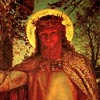Rhythm is a basic visual concept that must be understood to create compositions drawing and painting.
Modern Dance, 2008, by Fred Hatt
A drawing great rhythm where we can to see the forms of the human figures. Source
We can say that rhythm is as a flow of movement, generated by the repetition of elements with the same features. In other words, a continuous repetition of lines generates a linear rhythm , which directs the sight in one direction:
- A repetition of forms generates a formal rhythm, where the forms into the space mark this movement.
- A repetition of colors generates a chromatic rhythm, where the sight is directed towards the different points where the colors are repeated and this call more the spectator attention.
- And finally we have a repetition of lights or shades, which generate a light rhythm (there are forms and diverse colors but the tones do the rhythm).
In addition, the order how the visual elements are arranged it will mark the speed or intensity of the rhythm.
One of the most famous artworks with rhythm is Marcel Duchamp’s futurist painting:

Nude Descending a Staircase by Marcel Duchamp. See Wikipedia
It is a perfect example of repetition of forms, repetition of lights, and with a harmonic game of colors that integrates everything in a set. This rhythm directs the sight downwards thanks to the whole composition.
The rhythm and the figuration
The human figure in movement is a topic with many beauty. It can be a dance or the way of walking of a person or a sport exercise or many other activities that the human body can do. In the representation of these scenes it is necessary to understand the concept of rhythm. The figures give the idea of movement but we will need to paint or draw some repetitions to be able to generate the movement.
A work of the painter Ernst Ludwig Kirchner gives us another example of rhythm:
Six Dancers (Seis bailarinas), óleo sobre lienzo de 1911. See the artwork in Google art project
Ritmo con forma (las figuras de las bailarinas) y color (el rosa), e incluso por igualdad tonal.
The rhythm and the nature
In the representation of nature we can also take advantage of the idea of rhythm and create very interesting and beautiful images.
This David Hockney’s work, with blue lines for the image and towards the background, it has a soft light and color, more dark in the first plane, and that is smoothed by the reduction of the contrast.
Garrowby Hill, 1998 oil on canvas, 60×76 in. Source
The rhythm and the abstract art
In the abstract painting there is very much game of rhythm with repetitions of forms, lights, colors, etc. One of Kandinsky’s goals in his creation of abstract artworks was precisely to be able to represent the rhythm and the music with the painting art. He found in the abstract form the best way of expressing them, because the rhythm can be marked much easier if the form is more synthetic.
Here I show an example by Nino Di Salvatore:
Pulled Space Structure, de Nino Di Salvatore. Oil on canvas 1952 w116 x h86 cm
In this work the big linear forms are all in movement.
The Idea-Motion-Fight by Johannes Molzahn, painted on 1919. w139 x h149 cm. Source
How to give life to your artwork adding rhythm on the composition
Our decisions to place the forms, lights and colors, they must be thought with the concept of rhythm. In a work there can be more or less pace, from a void pace, for being a very flat work, up to a very frantic pace, based on thousands of forms and repetitions. According to the pace that we want to transmit, more rapid or slow, we will need to draw or to paint those repeated forms.
The rhythm must not be understood only in a global way, of the whole topic, but also as the small elements inside the image that they will be repeated: for example, the small brushstrokes to represent the leaves of a tree, or as the following work, the thorns of a cactus, repeated inside the forms of cactus.
Cactus Garden by Snake Jagger
And sometimes, the artwork only needs a littles of rhythm to be nice:
Bora Bora 1979-80 Edition of 100 lithograph 34 1/2 x 48 in
David Hockney was a great painter of the rhythm, with a lot of work of repetitions, both like simple brushstrokes and like more complex forms.
For example this pace based on armchairs … forms repeated in meaning, but not exactly in the visual form:
Large Interior, Los Angeles, 1988, oil, paper & ink on canvas, 72×120 in. Source
So, to think about the rhythm always is a good element to add in our artworks and composition. This gives it more quickness and energy to the image and even the sense of the topic.
















